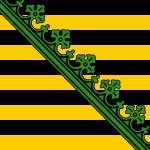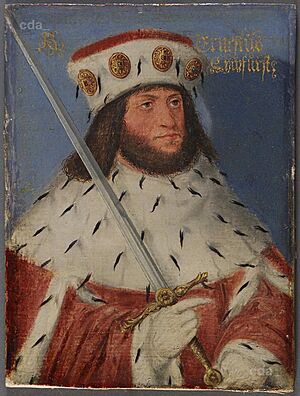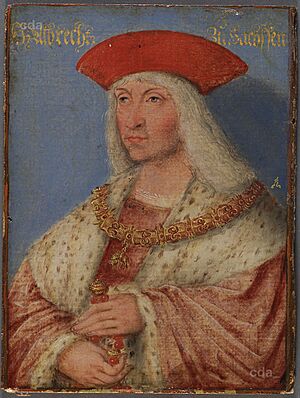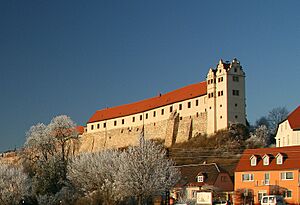House of Wettin facts for kids
| House of Wettin |
|||
|---|---|---|---|
Quick facts for kids  |
|||
| Country: | Saxony | ||
| Titles: | Margrave of Meissen, Landgrave of Thuringia, Duke of Saxony, Grand Duke of Saxony, Elector of Saxony, King of Saxony | ||
| Founder: | Thiedericus | ||
| Final Ruler: | Many sovereigns in different states until 1918 | ||
| Current Head: | Prince Michael, titular Grand Duke of Saxony | ||
| Founding Year: | 900s A.D. | ||
| Dissolution: | 1918 | ||
| Ethnicity: | German | ||
| Cadet Branches: | In order of seniority: Saxe-Weimar-Eisenach (Grand Duchy of Saxony) Saxe-Meiningen Saxe-Coburg and Gotha Saxony (Kingdom of Saxony) |
||
The House of Wettin was a very old and important family of rulers in Germany. For over 800 years, members of this family were counts, dukes, and even kings. They mainly ruled in areas that are now the German states of Saxony and Thuringia.
But the Wettin family's influence spread far beyond Germany! They also became kings of Poland. Even today, members of the Wettin family rule as kings and queens in Great Britain and Belgium. The last king of Bulgaria, Simeon II, was also a Wettin. He even became Prime Minister of Bulgaria later, which is very unusual for a former king!
Contents
The Wettin Family's Beginnings
The first known member of the Wettin family was Thiedericus, who lived around the year 982. Around the year 1000, the family gained control of Wettin Castle. This castle is in a place called Wettin, Saxony-Anhalt, near the Saale River. It was common for noble families to take the name of their main castle or territory. So, they became known as the House of Wettin.
How the Wettin Family Split Up
Over time, the House of Wettin divided into two main parts: the Ernestine line and the Albertine line. These two branches were named after two brothers, Ernest and Albert.
The Ernestine Branch
The descendants of Ernest often divided their land among themselves. This created many smaller duchies, which were like small kingdoms. One of these smaller duchies, called Saxe-Coburg and Gotha, became very important later on.
The Albertine Branch
Albert was Ernest's younger brother. His descendants became the powerful Electors of Saxony. An Elector was a special prince who had the right to vote for the Holy Roman Emperor. Later, in 1806, the Albertine line became the Kings of Saxony.


The Famous Saxe-Coburg and Gotha Family
The Dukes of Saxe-Coburg and Gotha came from the Ernestine branch. This family became incredibly influential across Europe.
Their descendants became:
- Kings of Belgium starting in 1831.
- Kings of Bulgaria from 1908 to 1946.
They also married into other royal families:
- A Saxe-Coburg and Gotha prince, Ferdinand II of Portugal, became the husband of the Queen of Portugal.
- Prince Albert, husband of Queen Victoria of the United Kingdom, was also from Saxe-Coburg and Gotha. This meant that the British royal family became part of the Wettin family.
Even the wife of the Emperor of Mexico, Carlota, was a member of this family.
Changing Royal Names
During World War I, many countries were fighting Germany. Because the British Royal Family had a German name (Saxe-Coburg and Gotha), King George V decided to change it. In 1917, they officially changed their family name to Windsor. This new name sounded more British.
The Kings of Belgium also stopped using the Saxe-Coburg and Gotha name. However, they never officially changed it like the British did.
Other Wettin Family Lines
Over the centuries, the Wettin family created many different lines and ruled various territories. Some of these included:
- Margraves of Meissen
- Dukes of Saxony and Landgraves of Thuringia
- Electors and Kings of Saxony
- Dukes of Saxe-Altenburg, Saxe-Weimar, Saxe-Eisenach, Saxe-Gotha, and Saxe-Meiningen.
- Kings of Portugal (known as Saxe-Coburg-Braganza)
- Kings of Bulgaria (sometimes called "Sakskoburggotski")
- Kings of Belgium
- Kings and Queens of the United Kingdom (now known as the House of Windsor)
Related pages
- Rulers of Saxony, a list that includes many members of the Wettin family.
- Wettin, Saxony-Anhalt, the town where the Wettin family first came from.
Images for kids
-
Catholic members of the Royal Albertine branch of the House of Wettin buried in the crypt chapel of the Katholische Hofkirche, Dresden
-
Altenburg Castle
-
Eisenach Palace
-
Hildburghausen Castle
-
Meissen (near Dresden)
-
Augustusburg Hunting Lodge (near Chemnitz)
-
Hubertusburg Castle (near Leipzig)
-
Friedenstein Castle, Gotha (winter residence)
-
Wartburg near Eisenach (1250–1406: residence of the Wettins)
-
Wittenberg Castle, residence of Frederick III, "the Wise", built 1490–96
-
Hartenfels Castle in Torgau, main residence of the Ernestine Electors since Frederick III, "the Wise", built 1533–40
-
Moritzburg Palace in Zeitz
-
Neu-Augustusburg Castle, Weissenfels
See also
 In Spanish: Casa de Wettin para niños
In Spanish: Casa de Wettin para niños




























